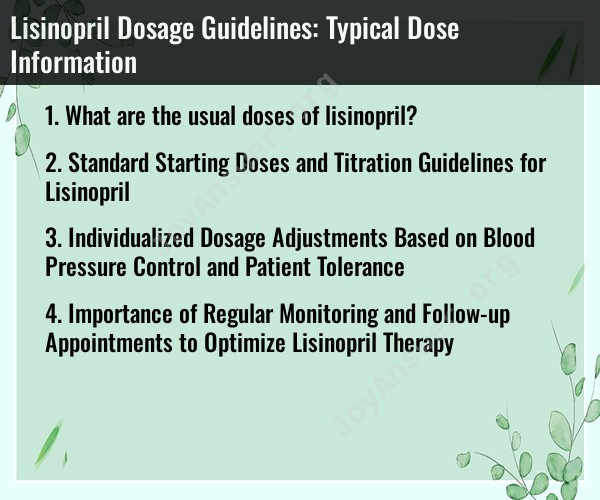What are the usual doses of lisinopril?
Lisinopril is an angiotensin-converting enzyme (ACE) inhibitor commonly used to treat conditions such as hypertension (high blood pressure), heart failure, and certain cardiovascular disorders. The usual doses of lisinopril can vary based on the specific medical condition being treated. It's important to note that individual patient needs may vary, and the prescribed dosage should be determined by a healthcare professional. The following are general guidelines for typical lisinopril doses:
Hypertension (High Blood Pressure):
Starting Dose: The typical starting dose for hypertension is often 10 mg once daily.
Maintenance Dose: The maintenance dose is commonly in the range of 20 to 40 mg once daily.
Maximum Dose: In some cases, the maximum dose may be higher, up to 80 mg per day, depending on the patient's response and tolerance.
Heart Failure:
Starting Dose: For heart failure, the initial dose may be lower, such as 2.5 to 5 mg once daily.
Titration: The dose may be titrated upward gradually under close medical supervision to reach the target maintenance dose.
Maintenance Dose: The maintenance dose for heart failure is typically in the range of 20 to 40 mg once daily.
Post-Myocardial Infarction (Heart Attack):
Starting Dose: The initial dose post-myocardial infarction may be 5 mg within 24 hours of the onset of symptoms.
Maintenance Dose: The maintenance dose can be increased gradually, with frequent blood pressure monitoring.
Renal Impairment:
- Dosage Adjustment: In patients with renal impairment, the dosage may need to be adjusted based on the degree of impairment. This adjustment is typically guided by the healthcare provider.
Pediatric Dosing:
Hypertension (6-16 years): The starting dose for pediatric patients is often 0.07 mg/kg once daily (up to 5 mg).
Heart Failure (≥6 years): The starting dose may be 0.07 mg/kg once daily (up to 5 mg), and titration is based on patient response.
It's crucial for individuals to take lisinopril exactly as prescribed by their healthcare provider. Dosages may be adjusted based on the patient's response to treatment, and regular follow-up appointments with a healthcare professional are important to monitor blood pressure and overall health.
Patients should never alter their lisinopril dosage without consulting their healthcare provider. Additionally, healthcare providers may consider factors such as the patient's overall health, other medications they are taking, and the presence of any contraindications or side effects when determining the appropriate lisinopril dosage.
Standard Starting Doses and Titration Guidelines for Lisinopril
Lisinopril is an angiotensin-converting enzyme (ACE) inhibitor used to treat high blood pressure (hypertension) and heart failure. The standard starting dose for lisinopril is 5 mg taken once daily. This dose can be adjusted upwards or downwards based on the patient's blood pressure control and tolerance to the medication.
Titration Guidelines for Lisinopril
If blood pressure is not adequately controlled after 2-4 weeks, the dose can be increased to 10 mg once daily.
If blood pressure remains uncontrolled after another 2-4 weeks, the dose can be further increased to 20 mg once daily.
The maximum recommended dose of lisinopril is 40 mg once daily.
Individualized Dosage Adjustments
The dosage of lisinopril should be individualized based on the patient's age, kidney function, and other concurrent medications. Patients with impaired kidney function may require lower doses of lisinopril.
Importance of Regular Monitoring and Follow-up Appointments
Regular monitoring of blood pressure is essential to ensure that lisinopril is effectively controlling blood pressure. Patients should also be monitored for any side effects of the medication, such as dizziness, headache, or fatigue.
Follow-up appointments with a healthcare provider are important to assess the patient's overall response to lisinopril therapy and make any necessary dosage adjustments.
Here is a table summarizing the standard starting doses and titration guidelines for lisinopril:
| Indication | Starting Dose | Titration | Maximum Dose |
|---|---|---|---|
| Hypertension | 5 mg once daily | Increase by 5-10 mg every 2-4 weeks as needed | 40 mg once daily |
| Heart Failure | 2.5 mg once daily | Increase by 2.5 mg every 2-4 weeks as needed | 20 mg once daily |
Note: These are just general guidelines. The specific dosage of lisinopril for each patient should be determined by a healthcare provider.












